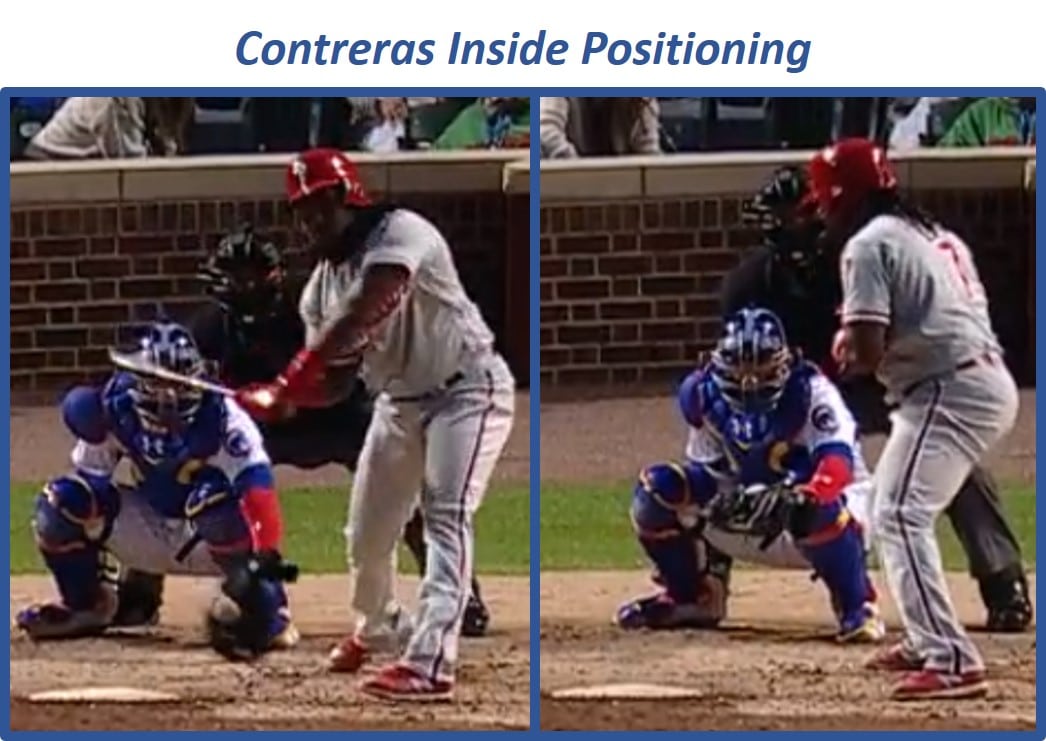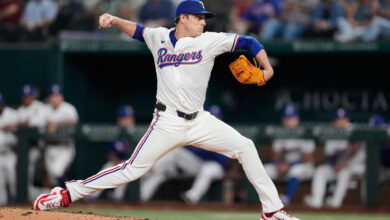
Cubs-Phillies Rewind: Significance of Pitch Framing and Catcher Positioning Examined
Last night’s exciting success against Aaron Nola and the Phillies bullpen sure salved that game one loss. But the memory lingers. With Kyle Hendricks matched against the Phillies’ struggling right-hander Zach Eflin, it seemed like a great chance for the Cubs to jump ahead in the series.
Alas, it ended with a 6-1 defeat for the Cubs. However, a rewind of that game’s decisive second inning deserves closer dissection. That was the inning when the Phillies went from expecting to be out-pitched to leaping out to a 2-0 lead that psychologically felt even larger with a gusty wind blowing in at Wrigley Field.
Hendricks had started the game well, breezing through the first inning on 10 pitches. Then, leading off the second inning, clean-up hitter Carlos Santana grounded out on an 0-1 changeup. Everything seemed to be going according to plan.
But against Aaron Altherr, Hendricks lost his command with four consecutive balls that weren’t very tempting. Then Phillies’ leftfielder Nick Williams worked the count to 3-1. Hendricks tossed a meaty fastball down the middle of the plate and a souvenir sailed over the right field wall.
Hendricks is responsible for his shaky command on that pitch and the batter before. But Willson Contreras and his pitch framing did him no favors. Now it’s not news to say Contreras is a below-average pitch framer (currently dead last in Baseball Prospectus’s “Framing Runs” stat). Cubs Insider’s own Teddy Elay nicely addressed this in an excellent off-season piece. But the “why” is a very interesting topic to dive into.
As a converted catcher, Contreras lacks a sharp command of various catching fundamentals. And that’s not really a surprise. The one that most concerns us here is Contreras’ inconsistent set-up before pitches. Much is written about pitchers repeating their deliveries, but less is said about how the more consistent a catcher is in his set-ups behind the plate, the more consistent and accurate the umpire can be behind him.
Consider Hendricks first two pitches before the Williams home run. Hendricks jumped ahead with a first-pitch called strike. But then, with nearly the same exact pitch and location on his next delivery, he didn’t get this call. So instead of going up a decisive 0-2, the count evened and gave Williams new life.
The similarities in the pitches can be seen in the two above pictures. First, notice how perfectly Hendricks replicated his follow through. A little less observable is how Contreras received the second pitch about four extra inches off the plate. This is more apparent in the next picture below that superimposes both set-ups.
Of course, one can blame the ump for inconsistency; however, on a previous hitter, home plate umpire Jordan Baker called a similarly located sinking fastball a strike. But only on this third pitch did Contreras change his set-up.
The first two times, he positioned with most of his body in the strike zone. The third time, he did a little hop while in his crouch and set-up four inches further outside, which then put the majority of his body outside the zone.
Was this on purpose by Contreras or just an inexact result of his final hop? Either way, it’s less than ideal. With Contreras positioned four inches further off the plate, the replay shows Contreras reaching across his body to catch the 0-1 pitch, whereas with the first pitch required none of this.
Now should an umpire ignore catching styles and framing? Of course, but they are human. Even though Hendricks threw exactly the same pitch to nearly the same spot, the umpire, no doubt, registered that Contreras caught the second one slightly differently. Was that key to the different calls? That’s impossible to know, but the best way for a catcher to limit this variable is to be as consistent as possible in his set-up.

Further, Contreras’ penchant for positioning a majority of his body out of the strike zone introduces extra variability on inside pitches. When he hops over (usually just as the pitcher’s delivery starts), the home plate umpire must make a last-moment adjustment. He then usually repositions himself further inside and slightly higher in his crouch.
This alters the umpire’s ideal eye angle for judging a pitch, making those calls on pitches on the black that much more challenging. If the pitch called for is intended to not be in the zone – i.e. designed only for a strike if fouled or swung through – but often you see this set-up by Contreras on pitches that seemed thrown to catch the edge or corner of the strike zone.
You can see how an umpire has to readjust in the first GIF in Teddy Elay’s piece. In the side-by-side pictures above, notice how the umpire’s ideal inside-pitch positioning changes as Contreras sets up further and further inside. These shots are from last night’s game Quintana pitched. In the picture to the right, you can see Umpire Jerry Layne’s head is higher up against the brick wall behind. He’s also not directly over the inside corner as preferred.
Might have going up 0-2 on Williams prevented that home run and perhaps changed the outcome? Maybe. The Williams home run definitely shifted the psychological momentum for the Phillies, just as Rizzo’s homer off Nola the last night did for the Cubs. The important take-away is when playing competitive teams like the Phillies, every small advantage and disadvantage can be significant.

